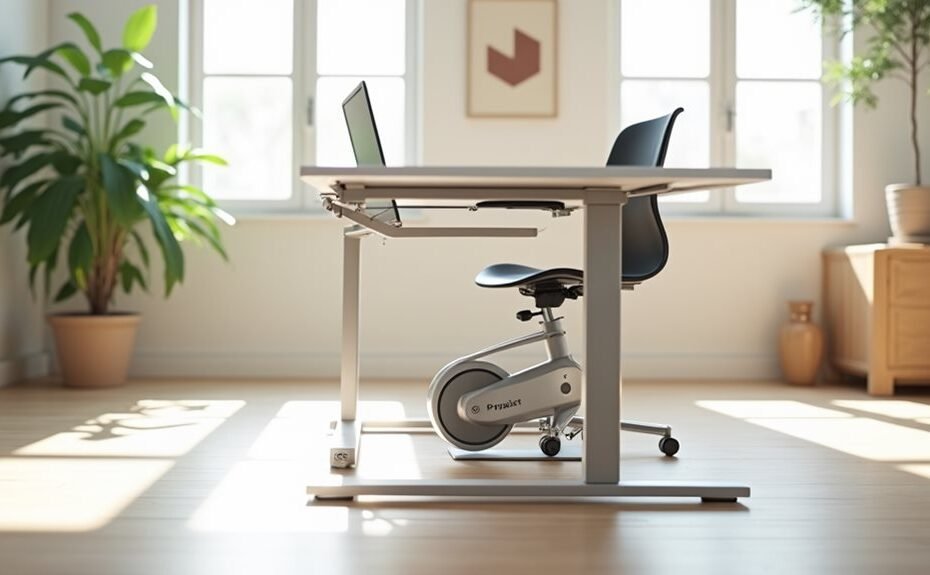Picture yourself pedaling gently beneath your desk while typing, your legs in constant motion like a peaceful stream flowing through your workday. I've discovered that desk exercise bikes aren't just another wellness trend – they're transforming how we approach our sedentary work lives. As someone who spends countless hours at my computer, I've experienced firsthand how these innovative devices can revolutionize a workspace. Whether you're looking to boost your daily calorie burn or enhance your focus, there's more to these compact fitness solutions than meets the eye.
Key Takeaways
- Under-desk bikes allow simultaneous work and exercise, doubling energy expenditure while improving concentration and productivity.
- Quality desk bikes feature magnetic resistance with 8-16 levels, LCD displays tracking metrics, and silent operation for office environments.
- Look for models with at least 9-inch desk clearance, ergonomic seat adjustments, and non-slip pedals for comfortable use.
- Effective desk bikes weigh 20-23 pounds for stability, include wheels for mobility, and offer compact, foldable designs.
- Regular use can burn 100-200 calories per hour while reducing heart disease risks and enhancing cognitive performance.
Benefits of Under-Desk Cycling
Under-desk cycling's most notable advantages span physical, mental, and practical benefits that can transform your workday. I'll tell you straight: you're looking at double the energy expenditure compared to sitting still. That's real calorie burn while you're answering emails or crunching numbers. The display screen provides motivation by showing your speed, distance, and calories burned throughout the day.
Let's talk muscles. You'll strengthen those hamstrings and improve leg muscle balance while boosting circulation. Your heart will thank you, and so will your digestive system. But here's where it gets interesting: your brain benefits too. I've seen the research – students show improved concentration and academic performance with under-desk cycling. The activity releases dopamine chemicals that enhance your mood and productivity. You'll channel that restless energy productively instead of fidgeting with your pen.
Want the practical perks? You're getting adjustable tension levels, tracking displays for speed and calories, and it works seamlessly with your existing desk setup. Plus, you won't need a bike seat – this isn't your spin class. The ergonomic benefits are undeniable: better posture, reduced leg pressure, and increased joint lubrication.
In cold offices? You'll stay warm while you work. No more frozen toes during winter meetings.
Choosing Your Perfect Desk Bike
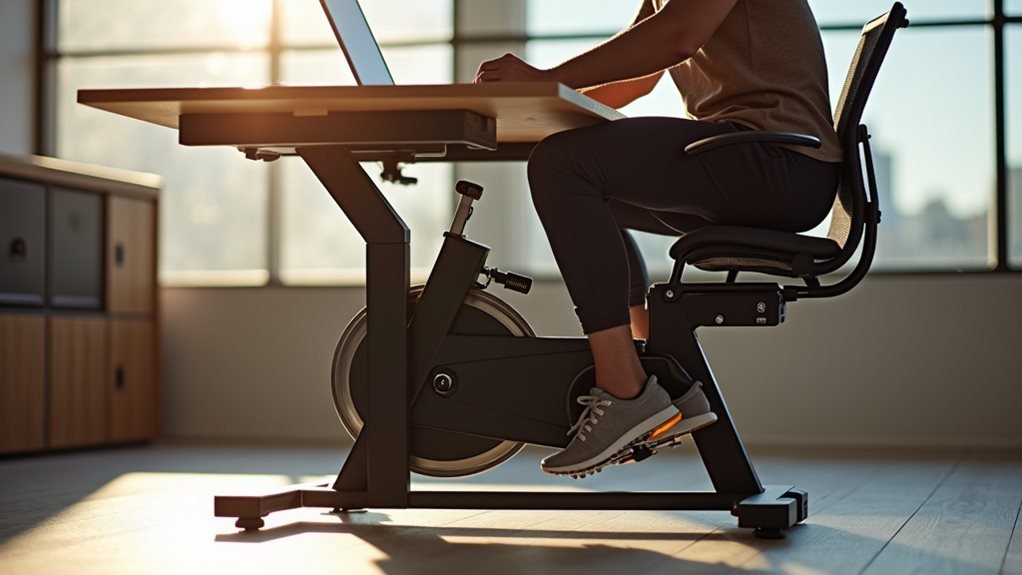
Now that you understand the impressive benefits, let's find the desk bike that'll work best for you. I'll cut straight to the chase – your perfect desk bike needs three essential features: adjustable resistance, proper fit, and reliable tracking. Don't compromise on these core elements. The magnetic resistance systems provide the quietest operation for office environments.
- Resistance settings must range from gentle (for long workday sessions) to challenging (for those intense focus periods) – look for at least 8 levels of magnetic resistance
- Height adjustability is non-negotiable – you need a minimum 9-inch clearance to prevent knee-desk collisions. The DeskCycle 2's 9 to 10-inch height range makes it particularly versatile for various desk setups.
- Display metrics should track time, distance, and calories – bonus points if it syncs with your smartwatch
I recommend focusing on weight and stability next. You'll want something heavy enough to stay put (around 20-23 pounds is ideal) but not so bulky that you can't move it. Look for non-slip features and a footprint under 24" x 20". And don't let price be your only guide – cheaper models often skimp on durability. Remember, you're investing in both your health and productivity. A quality desk bike will last years, making that initial investment worth every penny.
Setting Up Your Workspace
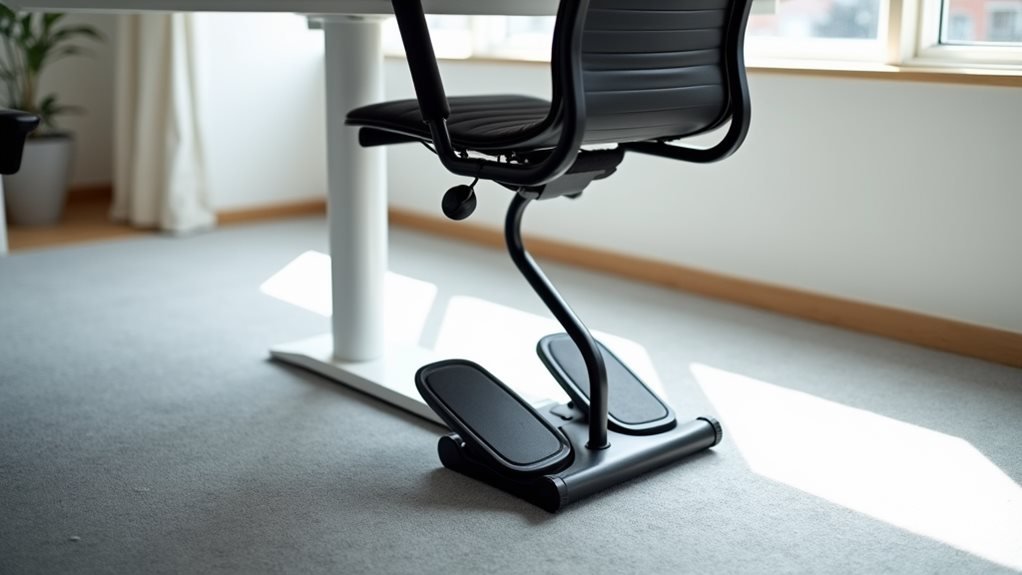
A well-configured workspace makes all the difference when integrating a desk bike into your daily routine. I'll show you how to set up your space for maximum comfort and productivity. First, position your WIRK Ride on a level surface, using those handy leveling endcaps to eliminate wobble. Trust me, you don't want a shaky ride while typing. The included foam grip handles provide extra stability while exercising. The design ensures reduced sick leave and a better working atmosphere through active movement.
Let's break down the vital setup dimensions:
| Element | Minimum | Maximum |
|---|---|---|
| Desk Width | 17.25" | 17.25" |
| Desk Depth | 10" | 10" |
| Height | Adjustable | Standing |
Now, you'll want to dial in your ergonomics. Adjust your seat height until your legs extend comfortably during pedaling – no knee strain allowed. The adjustable desk height is essential; I recommend starting at elbow level when seated, then tweaking until you find your sweet spot. Don't forget to position that tablet prop at eye level to prevent neck strain.
For your tech setup, I suggest mounting your workout monitor where you can easily glance at it. The whisper-quiet mechanism means you won't disturb colleagues, and that magnetic tension control lets you shift intensity on the fly.
Resistance Training While Working
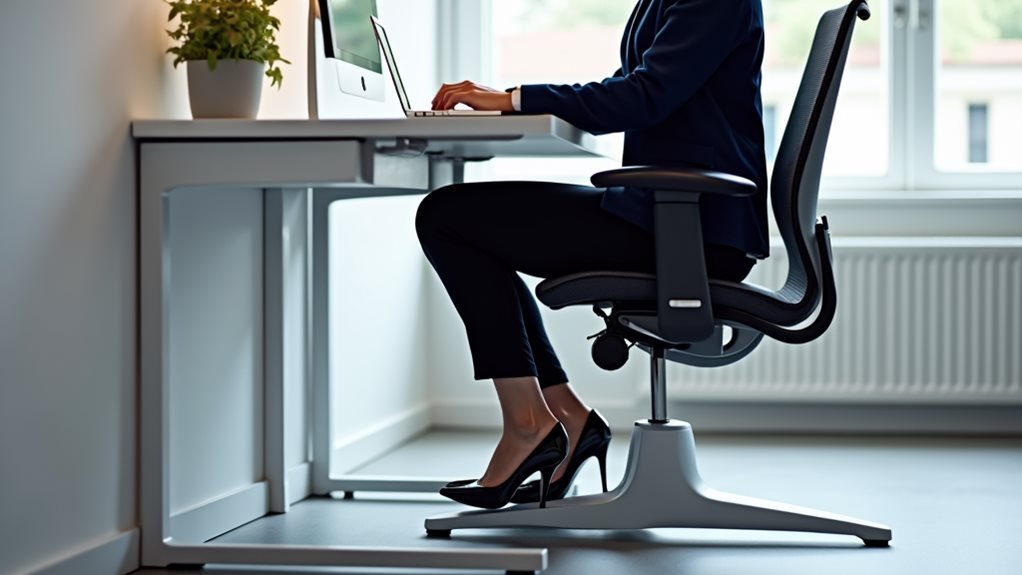
The beauty of resistance training while desk cycling lies in its versatility. I'm here to tell you exactly how to maximize your workouts while crushing those spreadsheets. With adjustable intensity levels up to 8 settings on most models, you're in complete control of your workout strength. The bi-directional stride motion allows you to target different muscle groups by pedaling both forward and backward. The textured pedal surface provides optimal grip during intense sessions.
Here's what you can expect from a proper desk cycling resistance workout:
- Silent magnetic resistance that won't bother your cubicle neighbors
- Quick-adjust tension dials for smooth shifts between strength levels
- Secure pedal straps that keep your feet locked in during vigorous sessions
I'll let you in on a secret: resistance training isn't just about your legs. Many desk bikes double as upper body workout stations. Want stronger arms? Place that bike on your desk and pedal with your hands. The magnetic resistance works just as effectively for bicep curls as it does for leg work. Trust me, you'll feel the burn either way.
The key is progression. Start low, master your form, then increase that resistance dial. Your muscles will thank you, and your productivity won't skip a beat.
Tracking Your Fitness Progress
Monitoring your fitness journey with desk bikes couldn't be simpler thanks to modern tracking technology. I'll tell you exactly what to expect: most models come with LCD displays showing your calories, speed, time, and distance – everything you need to stay motivated during your workday workout.
Want to sync with your Fitbit? No problem. Attach it to your ankle or shoe, and you're tracking steps while you pedal. Just know that heart rate data might get a bit wonky – that's normal with stationary cycling. For better accuracy, grab a third-party extender. You can also join the Fitbit Community forums to exchange tips and solutions with other desk bike users.
The real game-changer? Wireless monitors. They sit right on your desk, tracking everything from workout time to rotations per minute. And if you're into smart features, look for models with müüv integration. It's like having a personal trainer in your earbuds, minus the shouty motivation.
I recommend choosing a model with a scan feature – it cycles through your metrics automatically. Trust me, you won't want to manually check your stats while typing that quarterly report. The goal is seamless integration with your workday, not constant distraction.
Comfort and Ergonomic Considerations
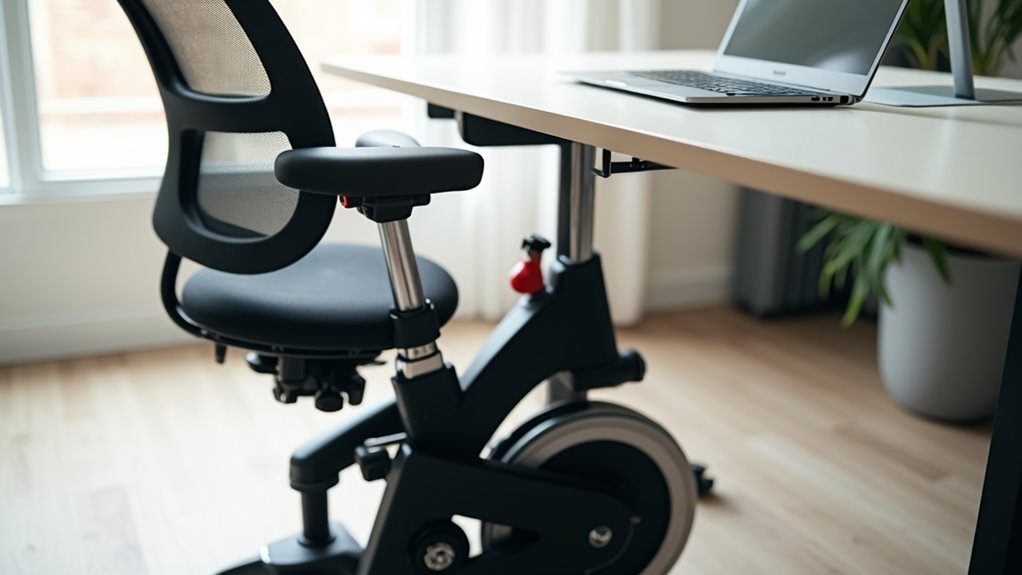
When it comes to desk exercise bikes, comfort and ergonomics make all the difference between a productive workday and an uncomfortable distraction. I'll tell you exactly what to look for concerning comfort features that'll keep you pedaling productively through your workday.
Let's start with the essentials you need for utmost comfort:
- Cushioned, adjustable seats with pneumatic height controls that'll save your backside during long sessions
- Ergonomic desk surfaces with non-slip grips, ranging from compact 20×20 inch spaces to larger workstations
- Silent pedal mechanisms with up to 16 resistance levels for distraction-free exercise
I've found that the best desk bikes offer both comfort and flexibility. You'll want a model that lets you adjust everything – from seat height to pedal positioning. The low-impact design ensures your joints stay protected while you exercise. Don't compromise on the desk surface either; it should be stable enough for your laptop and wide enough for your work materials.
The beauty of modern desk bikes is their mobility – many come with wheels and foldable designs. I recommend choosing one that's under 45 pounds if you plan to move it frequently.
Maximizing Your Daily Movement
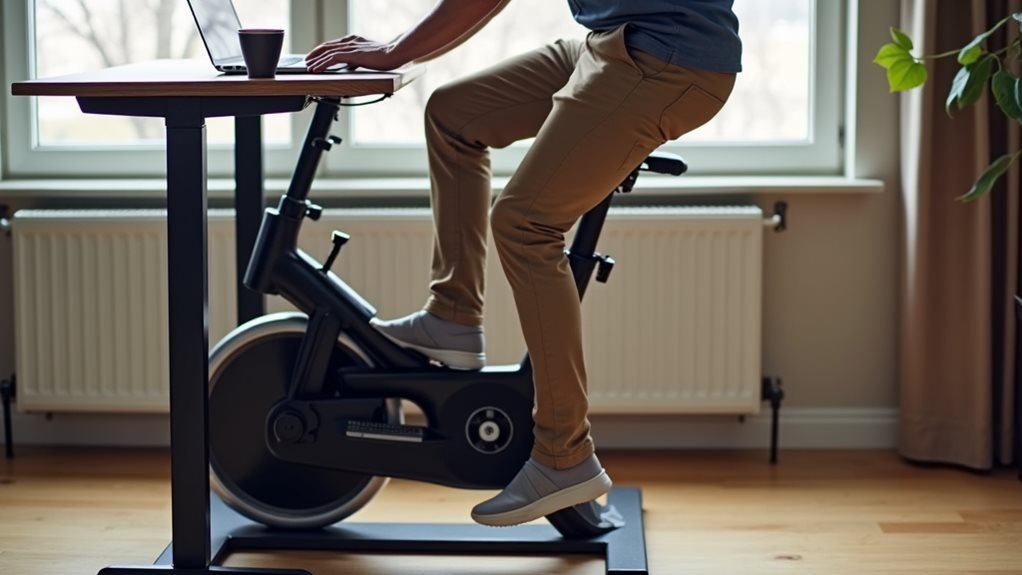
Now that you've got a comfortable setup, let's maximize your daily movement to get the most from your desk exercise bike. I'll show you how to transform your workday into a calorie-burning powerhouse that'll boost your brainpower too.
Start with 15-minute cycling sessions and gradually work up to longer durations. I'm talking 100-200 calories burned per hour – that's no joke. Your goal? Hit those physical activity guidelines while crushing your work tasks. Trust me, your cognitive performance will actually improve while pedaling.
Here's the kicker: even light pedaling counts. Brief bursts of vigorous cycling can slash your risk of heart disease and cancer mortality by up to 49%. I've seen complete exercise newbies work up to 180 minutes of cycling per workday. You can do this too.
Mix it up throughout the day. Pedal during phone calls, while reading emails, or when brainstorming. Your brain will thank you – cycling enhances working memory and problem-solving skills. Plus, you'll sleep better at night, which means better performance tomorrow. It's a win-win cycle that keeps on giving.
Maintenance and Storage Tips
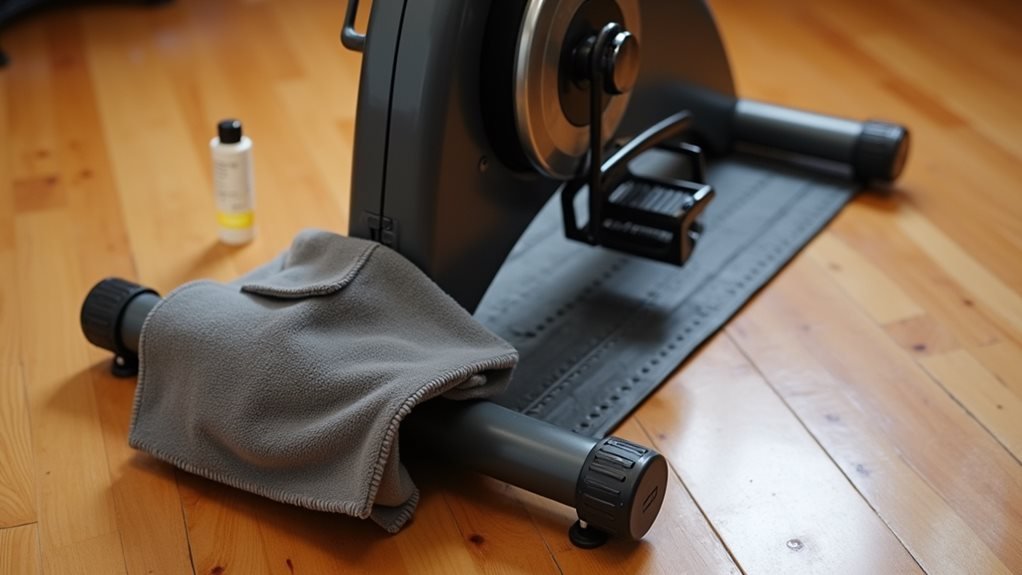
Proper maintenance and storage will extend your desk exercise bike's lifespan by years. I'll show you how to keep your investment running smoothly with daily, weekly, and monthly routines that'll prevent costly repairs. Trust me, five minutes of maintenance now saves hours of headaches later.
Let's start with the non-negotiables you need to do after every workout:
- Wipe down the frame, handlebars, and seat with antibacterial cleaner – sweat is your bike's enemy
- Check for any odd vibrations with a quick test ride – loose parts won't fix themselves
- Inspect seat and handlebar posts for stability – wobbles mean trouble
Monthly maintenance is where the magic happens. I'm talking about lubricating those critical points – pedal axles, crank bearings, and brake mechanisms. Don't skip the seat adjusters; they need love too. Think of it as giving your bike a spa day.
For storage, keep it simple: dry area, away from sunlight, and covered when not in use. Follow these steps, and your desk bike will be your faithful workout companion for years to come. No excuses – maintenance matters.
Frequently Asked Questions
Can Desk Bikes Be Used on Carpet Without Sliding?
I recommend using a mat when exercising on carpet, as desk bikes can slide and damage carpet fibers. Without a mat, you'll experience instability and potential safety issues.
Will Using a Desk Bike Make My Knees Hit the Underside?
I recommend ensuring at least 6-8 inches between your desk and pedals. You can adjust the desk height or bike position to prevent your knees from hitting the underside.
Does Pedaling Affect Typing Accuracy or Mouse Control While Working?
I've found that pedaling can make typing feel like you're juggling cats! Your typing accuracy drops at higher speeds, but mouse control stays decent if you keep moderate resistance and pace.
Can Multiple People Share One Desk Bike in an Office Setting?
I recommend sharing a desk bike with caution. While it's possible, you'll need to manage frequent adjustments, hygiene concerns, and scheduling between users to make it work effectively.
Do Desk Bikes Make Noise in Video Calls or Meetings?
I find most desk bikes are remarkably quiet during video calls. While pedaling at normal speeds, the noise level stays around 45 dB, which won't disrupt your meetings or disturb others.
